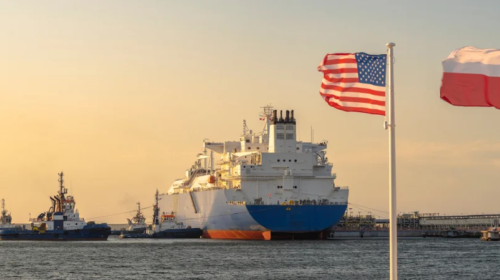Oil and Gas Regulatory Authority (OGRA) on Saturday issued a price-revision notification of Liquefied Petroleum Gas (LPG) for the month of May, decreasing the commodity price by Rs180.28 per 11.8-kilogram cylinder. According to the notification, the authority reduced the locally produced LPG price by Rs 15.27 per kilogram. After the revised price, the LPG cylinder would be sold in the open market at Rs2,735.83 in May, which was available at Rs2,916.11 in April. Whereas, the per Metric Ton (MT) LPG rate has been fixed at Rs231,850.07 for May. The commodity sale price per MT was Rs 247,128.35 in April. The new price would be effective from May 1.
They say the cure for high prices is high prices. The spectacular global rally in natural gas prices since last summer, which was put on a war footing with Russia’s invasion of Ukraine, has duly reignited investor interest in liquefied natural gas (LNG) export projects. However, that economic maxim holds true only if the extra supply the market is calling for can be brought online – and there are signs that runaway cost inflation could undermine efforts to build new US LNG export projects intended to supply gas-shocked Europe.
European wholesale gas prices have come off recent highs thanks to the continued supply of Russian pipeline flows – although the halt of gas to Poland and Bulgaria on 27 April cast doubt on how long that will continue – and strong LNG imports from the US and other global suppliers. However, UK and EU hub prices remain unseasonably elevated as the market struggles to price in more potential disruption as the war drags on.
Expensive gas ≠ more LNG
The ‘war premium’ on European gas hubs has worked, to the extent that it has lured spot cargoes of LNG away from supposedly ‘premium’ markets in Asia. Yet there simply isn’t enough spare uncontracted LNG swilling around the global market to satisfy European demand in the event that Russian flows are more widely banned or halted. Cue much speculation that Europe plans to go on an almighty buying spree of future LNG from unbuilt US projects.
That might yet come to pass, but only if buyers are comfortable locking in commitments to lift LNG from greenfield projects for a decade or more – and that will happen only if the cost of security of supply justifies the risk of being caught long when markets tank, as inevitably happens in highly cyclical global natural gas markets. Never mind markets that ultimately have to contend with the EU’s plan to be climate neutral by 2050.
That risk grows if buyers are forced to accept higher prices – and LNG project developers are facing spiralling costs that they will need to pass on in order to satisfy lenders and unlock project finance to reach final investment decision (FID). This concern is now real enough for engineering, procurement and construction (EPC) contractor Bechtel to renegotiate its contract to build Energy Transfer’s Lake Charles LNG project in Louisiana. Bechtel has also added $300m to its original $15.2bn EPC contract with Tellurian. Both of these projects are pre-FID.
Once bitten, twice shy
EPC contractors are right to be cautious because the LNG industry isn’t new to cost overruns. The Chevron-led Gorgon LNG plant in Australia is the classic example, finally costing $54bn – some $20bn more than estimated. In the US, contractors McDermott and Chiyoda were pushed into insolvency over cost blowouts when building the Cameron and Freeport LNG facilities in 2018. Chiyoda was bailed out by parent company Mitsubishi in 2019, and McDermott emerged from Chapter 11 insolvency protection in 2020.
Bechtel is a smart operator and probably won’t be caught out. The EPC company was last year careful to commit to build Woodside’s Scarborough LNG project in Western Australia with only 90% of costs under fixed cost/lump sum agreements, allowing it to pass on some cost increases to its client. Bechtel is clearly taking the same approach with its US LNG projects.
If EPC contractors won’t absorb higher costs, who will? In short: either buyers accept higher contractual prices, or equity investors absorb lower rates of return, or pre-FID projects don’t get built. Much will depend on the competitiveness of each project. Those with the lowest cost base stand the best chance of absorbing inflationary increases, while those at the other end of the spectrum are least likely to take FIDs.
The merit order effect
There are three main economic inputs that determine the cost competitiveness of an LNG project: the cost of capital, the cost of materials and labour (the capital outlay) and the cost of natural gas going into the plant (known in the trade as the ‘feed gas’). There are other considerations such as distance from the buyer (transport costs) and the seller’s ability to market large gas volumes to premium buyers – although when considering US LNG in isolation the shipping costs and achievable market prices are all roughly the same.
Those projects with the lowest cost of capital, lowest capital outlay per tonne of LNG and cheapest feed gas are the ones that attract buyers first and nail down offtake prices in sufficiently lengthy contracts (ten years-plus). With a low cost base and solid contractual arrangement that shares price and volume risk with buyers, margins are healthy and banks are happy to lend. Shovels go in the ground and investors pop champagne corks.
So, what happens when the cost of materials doubles and feed gas almost triples – just at that crucial moment when the LNG developer is marketing its future gas volumes to reticent buyers? (Reticent because while the EU says it wants more US LNG, that has hardly translated into commercial deals – so far. NextDecade finally signed a long-term sales and purchase agreement with Engie for 1.75 million tonnes per annum on 2 May 2022, but that deal remains the exception rather than the rule.)
Inflation is everywhere
US LNG developers are facing precisely this problem. The price of Chinese steel rebar, which is used to reinforce concrete, has rallied 80% from its Covid low of 3,300 yuan per tonne ($498/t) in April 2020 to peak at almost 6,000 yuan/t in Q3 2021, and is now trading at about 5,000 yuan/t.https://datawrapper.dwcdn.net/f1Qg9/2/
The benchmark price of hot-rolled steel from US mills hit a new all-time high of $2,143/t in October 2021 and is currently assessed at $1,567/t. In the years prior to 2020, the price exceeded $1,000/t on only two brief occasions. Yet it hasn’t dipped below $1,000/t since October 2021. War in Ukraine is adding upward pressure to prices: the US relies on Russia and Ukraine for roughly 60% of its pig iron supply, a key raw material for steelmaking. Exports from this region have fallen due to sanctions and supply disruptions since Russia’s invasion in February.
Wage inflation is another critical cost component of US energy projects. US wage inflation averaged 6.16% from 1960 until 2021, then spiked to an all-time high above 15% in April 2021, and is currently above 9%. McDermott and Chiyoda cited post-hurricane labour market tightness and soaring wages as major factors in the cost blowouts at the Cameron and Freeport LNG projects in 2018.https://datawrapper.dwcdn.net/vnbb6/3/
Technological advances could mitigate some of these inflationary pressures. Use of small-scale modular liquefaction trains that are fabricated off-site reduce construction costs. This is particularly beneficial in remote locations. The newest US LNG projects achieved record low per-unit build costs of almost $500/t of liquefaction capacity, compared with more than $1,000/t achieved in the first wave of construction. The Australian LNG boom of the mid-2010s saw unit costs breach $4,000/t at the Ichthys LNG project and $3,500/t at Gorgon, according to the OIES.https://datawrapper.dwcdn.net/L2nXh/1/
US gas is not immune
Keeping a lid on EPC costs is only part of the equation for new-build LNG projects, however. There is also the small issue of rising feed gas costs. The wholesale price of natural gas on US benchmark Henry Hub spiked from the typical sub-$3 per million British thermal units (MMBtu) to top $8/MMBtu in mid-April 2022, before falling back to the $7 range but remaining highly volatile. The trigger event was a late cold snap across north and north-eastern states driving unseasonal heating demand, but the market response was accentuated by depleted levels of gas held in underground storage following a period of exceptionally strong LNG exports to Europe.https://datawrapper.dwcdn.net/346BJ/1/
The irony for the US LNG industry is that the more it succeeds at ramping up exports, the more its feed gas costs will rise. The biggest constraint on Henry Hub price increases is the hard limit of US liquefaction capacity, which is operating practically at its physical limit. As more capacity comes online in the mid-2020s, the greater the exposure of Henry Hub to international pricing. The spread between Henry Hub and European gas hubs and Asia LNG spot prices will become structurally lower, squeezing the margins achievable by exporting LNG from US low-cost shale resources to premium global markets.
More supply, less demand – or both?
None of this is to say US LNG projects won’t be profitable, or won’t get built. The pace of dealmaking between Asian buyers and US sellers remains high, with South Korea’s state-run Korea Gas Corp last week becoming the latest to sign a long-term supply agreement, on this occasion with BP for 1.58 million tonnes per annum, indexed to Henry Hub.
This is the sort of deal US export projects need: a long-term contract for a large volume of LNG with a creditworthy offtaker that is willing to carry the can on rising feed gas prices for almost two decades into the future. The trouble is that there appears to be little European appetite for buying on these terms, and Asian buyers alone cannot underwrite the scale of upstream gas production and liquefaction investment needed to satisfy rising global demand for natural gas.
Unless that disconnect is resolved by a major readjustment in the economics of new LNG supply, the cure for high prices will have to come from the demand side. There are many factors at play, but one way this complex panorama might unfold is a failure to deliver new supply leading to structurally higher gas prices, forcing consumers to find alternative fuels and pushing European gas consumption into secular decline – and perhaps precipitating a deep recession along the way.






